The North Star, also known as Polaris, goes by many names including Kinosura, Alruccaba, Fenica, Navigatoria, Star of Arcadia, Yilduz, Mismar, Alpha UMi, α UMi, 1 Little Bear, BD + 88° 8, FK5 907, GC 2243, HD 8890, HIP 11767, HR 424, SAO 308, ADS 1477, CCDM J02319 + 8915.
Polaris is the brightest star in the constellation of the Ursa Minor, also known as the Little Bear. It is officially designated as α UMi (Alpha Ursa Minoris), but it is commonly referred to as Polaris. With an apparent visual magnitude of approximately 1.98, it is easily visible to the naked eye at night. Polaris is located less than one degree away from the Earth’s North Pole, which makes it the current North Pole star. Due to its historically stable position in the northern sky, Polaris has been an important navigational tool.
The revised parallax measurement of Hipparcos indicates that Polaris is approximately 433 light-years away (133 parsecs), although other calculations suggest a distance that is up to 35% closer. Despite appearing as a single bright point to the naked eye, Polaris is actually a triple star system. It consists of a main yellow supergiant called Polaris Aa, which is in orbit with a smaller companion known as Polaris Ab. This pair is also in a wider orbit with Polaris B. The outer pair, Polaris Aa, is in orbit with Polaris Aa. The discovery of the outer pair, Polaris AB, was credited to William Herschel in August 1779.
The celestial system
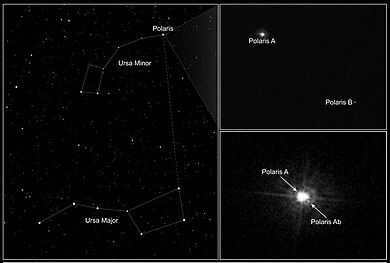
POLARIS Aa, a yellow supergiant star of the F7Ib spectral type, has evolved with a mass of 5.4 solar masses (M☉). It is noteworthy as the first classical Cepheid whose mass has been determined through its orbital characteristics. Accompanying Polaris Aa are two smaller stars: Polaris B, a main-sequence star of 1.39 M☉ and spectral type F3, which orbits at a distance of 2400 astronomical units (a.u.), and Polaris Ab (or P), a very close main-sequence star of spectral type F6 with a mass of 1.26 M☉. Polaris B is observable with a modest telescope. The star was originally discovered by William Herschel in August 1779 using his own reflector telescope, one of the most advanced telescopes of that era. In January 2006, NASA released images from the Hubble Telescope revealing the three members of Polaris’ triple system.
As a part of her doctoral thesis in 1955, E. Remer utilized radial velocity information to derive an orbital period of 30.46 years for the Polaris A system, exhibiting an eccentricity of 0.64. In 1996, KW Kamper refined these elements, determining a period of 29.59 ± 0.02 years and an eccentricity of 0.608 ± 0.005. Moving forward to 2019, the study conducted by R.I. Anderson yielded a period of 29.32 ± 0.11 years with an eccentricity of 0.620 ± 0.008.
Originally, it was believed that two more distant components, Polaris C and Polaris D, were associated with the Polaris system. However, subsequent research has shown that they are not physically related to the Polaris system.
Observation
Variability
Polaris Aa, the dominant element of the supergiant, is a well-known population I Cepheid variable star with a traditional low amplitude. In the past, it was mistakenly classified as a Type II Cepheid due to its high position in the Milky Way. Cepheids serve as crucial reference points for determining astronomical distances, thus Polaris, being the nearest star of its kind, has been extensively researched. The variability of Polaris has been under suspicion since 1852, and this hypothesis was finally confirmed by Einar Hertzsprung in 1911.
Polaris has a brightness range of 1.86-2.13, but the amplitude has undergone changes since it was first discovered. Before 1963, the amplitude was greater than 0.1 stellar magnitude and gradually decreased. However, after 1966, it decreased rapidly until it became less than 0.05 stellar magnitude. Since then, it has been fluctuating unpredictably within this range. Recently, there have been reports of the amplitude increasing again, and no reversals have been observed in any other Cepheid stars.
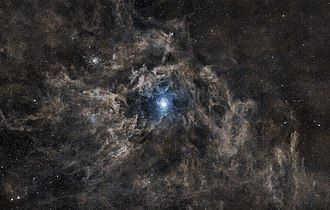
The period of approximately 4 days has also undergone changes over time. It has consistently increased by approximately 4.5 seconds per year, with the exception of a pause in 1963-1965. Initially, it was believed that this change was due to the gradual shift towards a red (lower temperature) state within the cepheid instability band. However, it is now speculated that it may be caused by interference between the primary and first overtone pulsation modes. There is disagreement among researchers regarding whether Polaris is primarily a first overtone pulsator or a primary tone pulsator, as well as whether it crosses the instability band for the first time or not.
The temperature of Polaris experiences only a slight variation during its pulsations, but the extent of this fluctuation is irregular and unpredictable. The unpredictable temperature shifts and the range of temperature changes during each cycle, ranging from less than 50 K to at least 170 K, could possibly be linked to the orbit with Polaris Ab.
The findings, which have been published in the journal Science, reveal that Polaris is currently 2.5 times brighter than when it was observed by Ptolemy, transitioning from being a star of third magnitude to second magnitude. Astronomer Edward Guinan views this as a remarkable transformation and has stated that “if these changes are indeed real, they exceed the predictions made by current theories of stellar evolution by a factor of 100.”
Due to the fact that Polaris is nearly aligned with the Earth’s axis of rotation “above” the North Pole, which is the northernmost point on Earth, Polaris appears to be almost stationary in the sky. As a result, all the stars in the northern sky appear to revolve around it. This characteristic makes Polaris an ideal point of reference for celestial navigation and astrometry. By measuring the star’s altitude above the horizon, one can estimate their approximate latitude.
In 2018, the Polaris star is located 0.66 degrees away from the center of rotation, which is 1.4 times the size of the moon. As a result, it follows a small circular path around the pole, with a diameter of 1.3 degrees. Its closest proximity to the pole, approximately 0.45 degrees, will occur shortly after 2100. Twice during each sidereal day, the azimuth of Polaris aligns with true north; at other times, it deviates to the east or west, requiring the use of tables or a rule of thumb to correct the azimuth. The most accurate approximation is achieved by referencing the leading edge of the asterism known as the “Big Dipper” in the constellation Ursa Major. By aligning the leading edge, defined by the stars Dubhe and Merak, with the dial, the true azimuth of Polaris can be calculated for different latitudes.
The future visible motion of Polaris towards and away from the celestial pole is a result of the precession of the equinoxes. After the 21st century, the celestial pole will shift away from α UMi, then it will come close to Gamma Cephei around the 41st century, and finally approach Deneb by approximately the 91st century.
The celestial pole was in close proximity to Tuban around 2750 BC, and during classical antiquity, it was slightly nearer to Cochabus (β UMi) than to Polaris, albeit still approximately 10 degrees away from either star. By the end of Late Antiquity, its angular distance from β UMi was about the same as its distance from α UMi. The Greek navigator Pytheas, around 320 BC, depicted the celestial pole as devoid of stars. Nonetheless, Polaris, as one of the most luminous stars near the Pole, has been utilized for navigation since at least late antiquity and referred to as ἀεί φανής (AEI Fanes) or “always visible” by Stobaeus in the fifth century. It can reasonably be described as a stella polaris from the Middle Ages onward. On his initial transatlantic voyage in 1492, Christopher Columbus had to locate “the circle described by stella polaris around the pole”. In Shakespeare’s play Julius Caesar, written around 1599, Caesar describes himself as “as constant as the north star”, even though there was no permanent polar star during Caesar’s time.
People’s Names
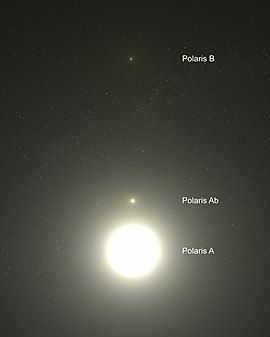
This illustration shows the supergiant star Polaris Aa, the dwarf star Polaris Ab, and the distant dwarf companion Polaris B.
The current designation for this celestial body, Polaris, is derived from the New Latin term Stella Polaris, which means “Polar Star.” This name was given during the Renaissance period when the star was observed to be within a few degrees of the celestial pole. In 1547, Gemma Frisius referred to it as stella illa quae polaris dicitur, meaning “that star which is called polar,” and stated that it was located 3° 8′ away from the pole of the sky.
In 2016, the International Astronomical Union established the Working Group on Star Names (WGSN) with the aim of compiling and normalizing official designations for stars. The inaugural bulletin of the WGSN in July 2016 featured a list of the initial sets of names endorsed by the WGSN, one of which was the Polaris Polaris α of the Little Bear Aa.
In ancient times, the closest star visible to the celestial pole with the naked eye was not yet Polaris, and instead, the entire constellation of the Little Bear was used for navigation. As time passed, Polaris gradually moved closer to the pole and eventually became the nearest star visible to the naked eye. However, even in the early Middle Ages, it was still a few degrees away. Since that time, many names have been used to refer to Polaris and its characteristic of being the closest star. In Old English, it was known as the “star-ship” or “scip-steorra.” Additionally, an Old English runic poem associates the T-rune with the “circumpolar constellation,” highlighting its quality of steadfastness and honor.
The ancient name of the constellation of the Little Bear, known as Kinosura (from the Greek word κυνόσουρα meaning “dog’s tail”), became linked with the polar star, especially during the Early Modern period. The clear identification of Mary as stella maris (which means “star of the sea”) with the polar star (Stella Polaris), as well as the use of Cyonsura as a star name, is evident in the name Cynosura seu Mariana Stella Polaris (meaning “Cynosure, or Marian Polar Star”), a collection of poems dedicated to Mary, published by Nicolai Lucensis (Niccolo Barsotti de Lucca) in 1655.
His traditional name in Arabic astronomy before Islam was al-Judayy الجدي ("goat" in the sense of a young goat [le Chevreau] in Description des Etoiles fixes), and this name was also used in Islamic astronomy during the Middle Ages. During that time, it was not yet located as close to the north pole of the world as it is today, and it was used to rotate around the pole.
Spenser referred to it as a representation of steadfastness in poetry, a “solid star”. Shakespeare’s “Sonnet 116” serves as an illustration of the symbolism of Polaris, with the following underlying principle: “[Love] is the guiding star for every wandering ship, whose unknown destination can still be determined.” In “Julius Caesar,” Caesar justifies his refusal to grant a pardon by stating, “I am as constant as the North Star, which remains immobile and without companions in the sky.” The heavens are filled with countless stars, each shining brightly, but only one holds its position. This is true in the world as well” (III, I, 65-71). Naturally, Polaris will not remain Polaris indefinitely due to precession, but this will not be noticeable until many centuries later.
In Inuit astronomy, Polaris is referred to as Nikirtsuituk. It is featured on the flag and coat of arms of Nunavut, Canada’s Inuit territory, as well as on the flag of the state of Alaska in the United States.
In the traditional star knowledge of the Lakota people, Polaris is known as “Wičháȟpi owáŋžila,” which translates to “The star that remains still.” This name originates from a Lakota legend in which Polaris marries Tapun San Win, also known as “The Redheaded Woman.” However, she tragically falls from the sky, causing Polaris eternal grief as he gazes down from “vaŋkatu,” the aforementioned land.
Stellar parallax serves as the foundation for the measurement of parsec, which represents the distance from the Sun to an astronomical object that exhibits a parallax angle of one arc second. (1 AU and 1 pc are not depicted to scale, with 1 pc being approximately equal to 206,265 AU)
Several recent research articles have computed the distance to Polaris to be around 433 light-years (133 parsecs) based on parallax observations conducted by the Hipparcos astrometric satellite. Previous estimations of distance were often slightly smaller, and investigations utilizing high-resolution spectral analysis propose that the distance may be 110 light-years closer (323 svL / 99 pc). Polaris is the nearest Cepheid to Earth, making its physical characteristics crucial for the entire astronomical distance scale. It is also the only celestial body with a dynamically measurable mass.
| A | 330 light-years (101 parsecs). | Turner |
| A | 433 light-years (133 parsecs) | Hipparcos |
| B | 359 light-years (110 parsecs) | Usenko and Klochkova |
| B | 323 light-years (99 parsecs) | Turner et al. |
| A | ≥ 385 light-years (≥ 118 parsecs) | Neilson |
| B | 521 light-years (160 parsecs) | Bond et al. |
| B | 445.3 light-years (136.6 parsecs) | Gaia DR2 |
| B | 447.6 light-years (137.2 parsecs) | Gaia EDR3 |
| A revised set of observations from 1989-1993, initially released in 1997 |
| B Statistical distance computed based on the dim distance to the |
The spacecraft Hipparcos utilized stellar parallax to make measurements in 1989 and 1993 with a precision of 0.97 milliseconds (970 microseconds), and it achieved accurate measurements for stellar distances up to 1000 pc. The Hipparcos data underwent further analysis employing more advanced error correction and statistical techniques. Despite the benefits of Hipparcos astrometry, uncertainties have been identified in its Polaris data, causing some researchers to question the accuracy of Hipparcos in measuring double cepheids like Polaris. The assessment of Hipparcos data specifically for Polaris has been reviewed and validated, but there is still no consensus on the distance.
The next significant advancement in precise parallax measurements involves the space-based astrometric mission Gaia, which was launched in 2013 with the goal of accurately measuring the parallax of stars to within 25 microseconds (μas). Originally, Gaia was intended to observe stars with a magnitude fainter than 5.7, but tests conducted during the commissioning phase revealed that Gaia could autonomously detect stars as bright as 3. When Gaia commenced its regular scientific surveys in July 2014, it was configured to regularly handle stars with magnitudes ranging from 3 to 20. In cases where this limit is exceeded, special procedures are employed to download raw scan data for the remaining 230 stars brighter than the 3rd magnitude. Methods are currently being developed to process and analyze this data, with the expectation of achieving “full sky coverage at the bright end” with standard errors of “a few tens of μsecs”. Although Gaia Data Release 2 does not include a parallax measurement for Polaris, it does provide a distance calculation of 136.6 ± 0.5 pc (445.5 sv. yr.) for Polaris B, which is slightly larger but significantly more accurate than previous estimates. This calculation was further refined to 137.2 ± 0.3 pc (447.6 svL) after the publication of the Gaia Early Data Release 3 catalog on December 3, 2020, which superseded Gaia Data Release 2.
For a long time, Polaris has played a crucial role in the cosmic distance ladder. Before the Gaia mission, it was the sole Cepheid variable with available direct distance data, which had a significant impact on distance measurements using this “ruler”.
History of Observation
| Ptolemy (~169) | yes |
| As-Sufi (964) | yes |
| Al-Biruni (~1030) | yes |
| Khayyam (~ 1100) | yes |
| Nasir al-Din al-Tusi (1272). | No |
| Ulugbek (1437) | yes |
| Copernicus (1543) | yes |
| Schöner (1551) | yes |
| Brahe (1598) | yes |
| Brahe (1602) | yes |
| Bayer ( 1603 ) | yes |
| De Houtman (1603) | No |
| Kepler ( 1627 ) | yes |
| Schiller ( 1627 ) | yes |
| Halley (1679) | No |
| Hevelius ( 1690 ) | yes |
| Flemsteed (1725) | yes |
| Flemsteed ( 1729 ) | yes |
| Bode (1801a) | yes |
| Bode (1801b) | yes |
Unique Content
Last Name
This star holds significant importance in various cultures and has been given numerous names to reflect its significance. Some of the names include Stella Polaris or simply Polaris and North Star. In ancient Greece, it was known as Phoenice (“Phoenician”). Other names associated with it are fisherman’s star, Cynosaura, Cynosura (Greek Κυνόσουρα meaning “tail of the dog”), Lodestar, Mismar, Navigatoria, Tramontana, ulpan, and Poljarnaja. Additionally, it is also referred to as the northern polar star.
In the field of astronomy, the systematic name for this star is α Ursae Minoris (Alpha Ursae Minoris) or α UMi for short.
The IAU Working Group on Star Names (WGSN) officially established the name Polaris as the standardized proper name for this star on June 30, 2016.
Three-star system
Polaris is an optical binary star system. In 1780, William Herschel discovered a companion star with a visual magnitude of 9 at a separation of 18.4 arcseconds. It wasn’t until 2006 that the Hubble Space Telescope resolved the fact that the host star itself is also a binary system. The two components of the host star are separated by 0.17 arcseconds.
For a period of time, the host star was classified as a variable pulsating Cepheid star, with its brightness fluctuating between 1.92 and 2.07 magnitudes over a period of 3.9 days. However, since around 1980, these fluctuations have gradually decreased and now only range from 0.01 to 0.02 magnitudes. Polaris is currently moving away from Earth at a speed of 17 km/s. Before its variability was discovered, Polaris also served as a reference star (zero point) for the scale of apparent brightness.
The order of the components in a close double star is as follows: Polaris Aa and POLARIS Ab are referred to as Polaris B. The main star of the system, Polaris, is a supergiant and is approximately 2000 times brighter than the Sun. It is located at a distance of approximately 430 light-years from us. Polaris Ab, on the other hand, is a dwarf star that orbits Polaris Aa in a retrograde orbit, approximately 20 astronomical units (3 billion kilometers, similar to the distance between Uranus and the Sun), for a duration of approximately 30 years. The two other potential companions, located at distances of 43 inches (C) and 83 inches (D), are unlikely to be part of the star system.
Polaris information
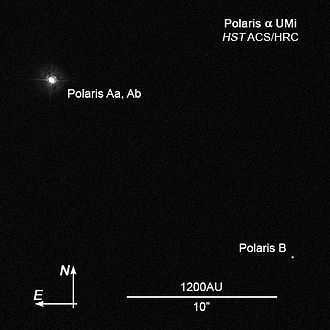
In the southern sky near the pole, there are no stars that shine as brightly as Polaris. However, there is a fainter star called Australian Polaris (σ Octantis) with an apparent magnitude of 5 sidereal magnitude that can be considered as Polaris’ twin.
Locate in the heavens
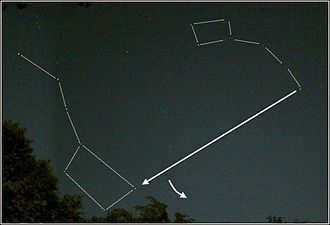
The constellation known as the Big Dipper, or simply the Dipper, is easily visible in the sky year-round in the northern latitudes. By extending the imaginary line connecting the two bright stars at the back of the Dipper, approximately five times, you will reach Polaris, which is about 1.5 times the size of the moon when viewed along this line.
α U M. a α U M. I ¯ sign equals 5 ⋅ α U M. a β U M. a ¯ \; \ alpha _ >> \ quad = \ quad 5 \ cdot \; \ beta _ > >
Alternatively, you can draw a line between the first and third stars of the Dipper (depending on the season and observer’s position) and the central star of Cassiopeia. Polaris is located approximately in the middle of this connecting line.
The position of the Big Dipper and Cassiopeia (as well as all other constellations) relies on the season, time, and latitude of the observer (also see sidereal time).
Polaris coordinates:
- Equinox 2000.0: right ascension 2 h 31 m 49 s, declination + 89° 15'51″
- Equinox 1950.0: right ascension 1 h 48.8 m, declination + 89 ° 02 ′
Polarstern: its history and what lies ahead

Watch the media file
The Earth’s axis in space is not stable, but it undergoes a slow circular motion. It takes approximately 25,700 years (known as the platonic year) for the Earth’s axis to complete one full rotation around the pole of the ecliptic, which is located in the constellation of the Dragon. This phenomenon is known as precession and it causes the celestial poles to shift. As a result, Kocab was initially considered as the polar star by Arab astronomers, while Yildun was considered as the polar star by Turkish astronomers. Tuban served as a polar star around 2800 BC.
Due to this shift in coordinates, Polaris is now undergoing a slight movement towards the Earth’s pole. The closest distance between them will occur in 2102, measuring at 0° 28′ 31″ 0.4753°, before gradually moving away again. In approximately 12,000 years, Vega, the primary star in the constellation Lyra, will once again take its place as the pole star. This phenomenon already occurred during the Stone Age around 14,000 years ago.
Here is a list of the corresponding polar stars:
The trajectory of the celestial north pole (the Earth’s axis of rotation) around the pole of the ecliptic. +2000 refers to the year 2000 in our calendar, during which the star of the Little Bear aligns with Polaris.
Symbolic utilization
The Alaska flag also incorporates a diagrammatic representation of the celestial position.
Further reading
External links
Wiktionary: Polaris – definition Meanings, etymology, synonyms, translations
Citations
- ↑ abcdef I. A. Usenko, V. G. Klochkova: Polaris B, an optical satellite of the Polaris system (α UMi): atmospheric parameters, chemical composition, distance and mass; in: Monthly Notices of the Royal Astronomical Society: Letters Vol. 387, Issue 1, pp. L1 – L3, bibcode: 2008MNRAS.387L.1U
- ↑ ab Evans et al: Direct detection of a close companion of Polaris by the Hubble Space Telescope; in: The Astronomical Journal, Vol. 136, Issue 3, pp. 1137-1146, bibcode: 2008AJ.136.1137E
- Bulletin of the IAU working group on stellar names, no. July 1, 2016. (PDF) Verified on November 9, 2016 (English, 184 KiB).
- ^ Evans et al: Polaris: mass and multiplicity; in: Double stars as critical tools and tests in modern astrophysics, Proceedings of IAU Symposium No. 240, held August 22-25, 2006, in Prague, Czech Republic; Cambridge University Press, 2007, pp. 102-104, bibcode: 2007IAUS..240..102E
- ^ After Norbert Gasch: Die Precession Astronomie.de/Arbeitsgemeinschaft Raumfahrt und Astronomie eV
- Kochab. Verified on June 18, 2017.
- > Anubis, companion of Osiris – Graham Hancock’s Official Site. (grahamhancock.com [accessed June 18, 2017]).
Polaris makes an irresistible request.

The star known as Polaris can be found in the constellation of Ursa Minor, near the North Pole of our planet. It has a stellar magnitude of +2.0, making it one of the brightest stars visible from Earth. Additionally, Polaris is the closest pulsating variable star to our planet. Due to its minimal movement in the daily rotation of the sky, it serves as a reliable point of reference for navigation. Its position is almost synonymous with the North direction. The star’s height above the horizon corresponds to the geographic latitude of the observer’s location. Those residing in the Polar Circle regard Polaris as an unwavering guide in the night sky.

Lovozero is the third largest lake on the Kola Peninsula.
Lovozero is situated in the heart of the Kola Peninsula. It spans from the northern to the southern parts. It is encompassed by tundra, marshy taiga, and in certain areas by hills. During winter, the polar night is silent and freezing. In summer, the sun never sets. This region is featured in the tale “Frosty Horror”. The attribution is given to Fridtjof Nansen, the renowned Norwegian explorer.

Uncommon illnesses in the wild.
The target of these forces are the Lopari or Saami people, who reside (resided) in small settlements and establishments on the Kola Peninsula. It is within this icy and desolate wilderness that a peculiar ailment known as MERKINS, or MANNERICK, or ARCTIC HYSTERIA occurs. This condition impacts not only the indigenous population, but also those who have recently arrived.

Back in 1792, young Alexei fell ill with scurvy while aboard his father Rybin’s fishing schooner. However, when the mesmerizing aurora borealis illuminated the night sky, he experienced a sudden burst of energy that enabled him to venture out onto the deck, leap into the icy waters, and swim towards the northern horizon. Sadly, his valiant effort could not save him.

The Gathering
In the year 1898, a Norwegian vessel decided to spend the winter near the shores of Antarctica. As the polar night descended and the mesmerizing aurora borealis danced in the sky, one of the crew members, driven by an inexplicable urge, abandoned the ship and ventured across the icy terrain towards the pole. Intrigued by his actions, another crew member followed suit, and when the rest of the crew tried to intervene, the escapee brandished an axe and nearly harmed the navigator before successfully making his escape. This incident led subsequent polar explorers to include straitjackets in their equipment, in order to restrain any individuals who might succumb to the irresistible allure of the North Star.

Dimension – is an uncommon term in the lexicon of the Russian Pomors. It refers to a peculiar mental disorder that can manifest in a few individuals. The Eskimos refer to this condition as “the beckoning of the Polar Star”. The very word “meryachenie” or “meryachenie” is derived from the verb “mireachenie”. It signifies “to be possessed”, “to be in a state of insanity”.

The Arctic Circle is home to a mesmerizing sight of trees covered in snow that transform into extraordinary beings, often resembling humans. This phenomenon, in my perspective, serves as a representation of the essence of a MERCHANT.
An episode of Arctic hysteria, also known as polar psychosis, initiates when an individual becomes completely detached from the surrounding reality and enters a trance-like state. The afflicted person engages in rhythmic motions like swaying and communicates in languages that they should not have knowledge of.

However, in many cases, it has been observed that it is drawn towards the north, seemingly guided by an unknown force. Despite efforts to divert it from its destructive path, it displays an incredible level of resistance and continues its rampage. Individuals who are sick and weakened are particularly vulnerable to the influence of this malevolent entity.
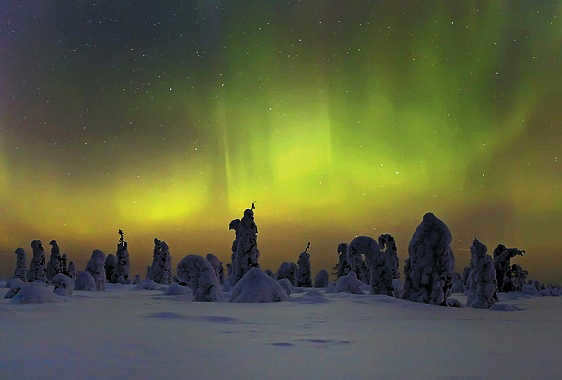
It is terrifying to witness a crowd overtaken by polar psychosis. The individuals sway and shout in various tones, resembling zombies. It is believed that they become completely numb to pain during these episodes. Furthermore, after the incident, they experience amnesia and have no recollection of what transpired.

The duration of a seizure can range from a few hours to a full day or night, and it may occur repeatedly over multiple days. The Yakuts typically attribute these seizures to the effects of spoilage or the presence of an evil spirit within the body. As a result, they often refer to these cases as being tormented by a demon.

Maneriks
There are different narratives surrounding the phenomenon of “maneriks” among the general public, such as their alleged ability to effortlessly impale themselves with knives without any visible marks, their uncanny ability to swim despite lacking the necessary skills, their aptitude for singing in an unfamiliar language, and even their alleged ability to foresee future events. Additionally, individuals who fall under the influence of maneriks seem to lose their autonomy and mindlessly imitate a series of repetitive movements.

There is a captivating legend that offers an intriguing explanation for this awe-inspiring phenomenon: the departed soul ascends to a celestial palace adorned with the radiant Polar Star. This ethereal palace remains unseen by the living, but when its ethereal inhabitants open their windows, a luminous glow emerges, creating the mesmerizing spectacle known as the polar lights. The opening of these celestial windows signifies the beckoning of the gods, calling upon the souls of those who still dwell in the mortal realm. And it is said that those who heed this divine summons embark on their final voyage towards Polaris.

It was discovered in 1957 through extensive experimentation that specific types of auroras exhibit a pulsating frequency that closely aligns with the fundamental rhythms of the human brain, leading to a disruption in its functioning.
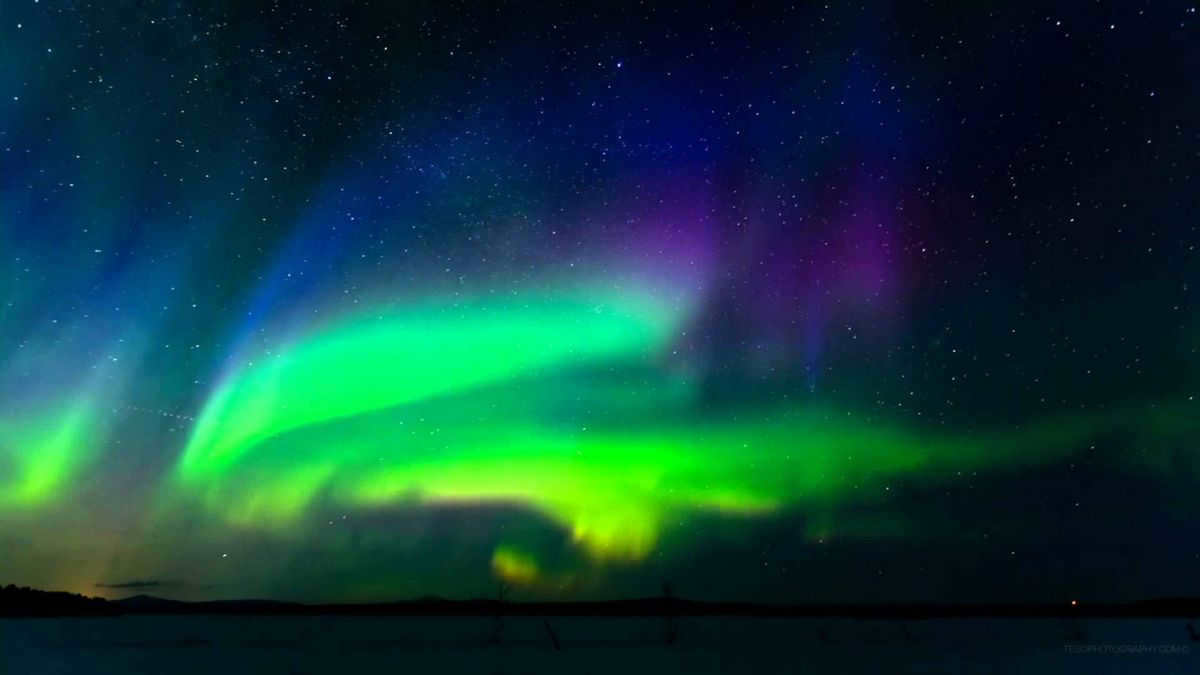
Psychosis and its correlation to the phenomenon of polar lights
Physicians who participated in subsequent expeditions made a fascinating observation. The majority of instances of polar rabies occurred simultaneously with the occurrence of the aurora borealis, particularly with displays of red hues. The frequency of these seizures notably rose during years with documented peaks of solar activity, coinciding with the occurrence of the most vibrant auroras.

Furthermore, it has been discovered that intense crimson bursts, resonating at frequencies similar to brain rhythms, have the potential to worsen chronic ailments and induce seizures resembling epilepsy. Certain individuals have reported excruciating headaches and disruptions in their sense of balance following exposure to these flashes. Those with a predisposition to mental illness are especially vulnerable to this particular form of stimulation.

Shamans actively employed the capacity to induce individuals into a state of flickering.
"Meryachenie", which resembled collective hysteria, typically manifested itself during mystical ceremonies, but could also arise spontaneously. The possessed "spirit" shares many similarities with a shaman and possesses the power and abilities of a shaman, thus connecting meryachenie and shamanism. The only distinction between the two is that the "manerik" invokes the "spirit" against the will of the patient, whereas the shaman invokes the "spirit" of their own volition and can command it.

Researchers believe that local shamans possessed the ability to induce a state of collective hysteria in a large group of people using a brief, powerful incantation. This spell effectively transformed individuals into compliant automatons who would carry out any command. The shamans extensively utilized the concept of arctic psychosis, a condition induced by a sudden and terrifying shout. They had a deep understanding of scare tactics, knowing the optimal time of day to induce fear and the specific incantation that would elicit a frightening response.

Legendary human-like creatures originating from the netherworld.
Through the utilization of this method of zombification, shamanic leaders coerced individuals into labor, facilitated reconciliation between enemies, and exacted punishment upon criminals through the transformation into mindless automatons for the remainder of their lives. This ritual was also employed to cultivate fearless and aggressive warriors. According to the shamans, their mastery of this technique stemmed from encounters with humanoid entities hailing from the netherworld. Hence, it is important to remember the name HUDI, as it is associated with these subterranean beings.

An incredible and extraordinary “fear technology” aided the NOIDA (shamans) in manipulating the Sami’s existence. The Noids themselves had faith in nobody except, according to the myths, WONDERS or CHAHKLI – legendary humanoid beings who emerged from the netherworld and imparted the knowledge of quantification.

In the late 19th and early 20th centuries, a phenomenon known as psychic contagion affected large groups of people in the Far North of Russia and Siberia. This term refers to the ability of shamans to manipulate ordinary individuals and control their actions, which had negative consequences for the history of shamanism.
This page is currently unverified and may differ significantly from the version that was verified on October 9, 2022. It requires 8 edits for verification.
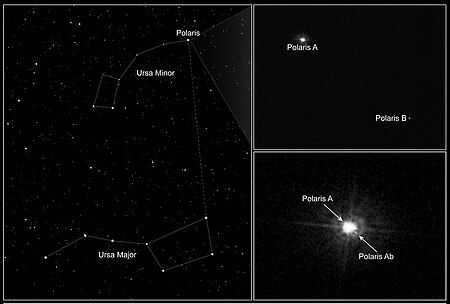
Polaris, also known as Cynosura, Alruccabah, Phoenice, Lodestar, Pole Star, Tramontana, Angel Stern, Navigatoria, Star of Arcady, Yilduz, Mismar, Polyarnaya, 1 Ursae Minoris, HR 424, BD +88°8, HD 8890, SAO 308, FK5 907, GC 2243, ADS 1477, CCDM 02319+8915, HIP 11767, is a unique star in the Little Bear constellation. It is a yellow supergiant star with a spectral class of F7Ib. Polapnaya stellá is located near the North Pole of the world. Its approximate distance from Earth is 447 ± 1.6 light-years (137.14 +0.53-0.52 parsecs) [2] [3].
Table of Contents
Description [ edit edit code ]
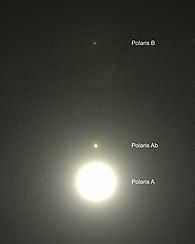
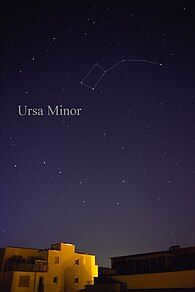
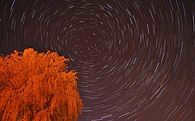
Polaris is a unique pulsating variable star of the Cepheus delta type that is the brightest and closest to Earth. It has a period of 3.97 days. However, what sets Polaris apart is its unusual behavior. Over the course of several decades, its pulsations gradually fade. In 1900, there was an 8% change in brightness, while in 2005, it was only about 2%. Interestingly, during this time, Polaris has also become, on average, 15% brighter.
Not only is Polaris a pulsating variable star, but it is also part of a triple star system. At the heart of this system is the supergiant Polaris A (α UMi A), which shines 2000 times brighter than our Sun and has a mass 6.4-6.7 times greater. It has a radius of 47-50 solar radii and an estimated age of 55-65 million years.
Another component of the system is Polaris B (α UMi B), which is located at a significant distance from Polaris A (2400 astronomical units). Despite this distance, Polaris B can still be observed through telescopes even from the surface of the Earth.
Polar B revolves around the α UMi A/P binary system in approximately 100,000 years. There are two additional distant components, known as α UMi C and α UMi D, but these stars are much older and not physically linked to Polaris [7].
It is plausible that Polaris and the nearby stars are remnants of a disbanded cluster. Based on Hipparcos and 2MASS data, the radial velocities of Polaris’ closest neighbors are nearly identical, and their average distance from Earth is roughly 100 parsecs. According to the “color – stellar magnitude” diagram created for the cluster, the age of its members (including Polaris) falls within the range of 80 million years [8].
In 1990, the European space telescope Hipparcos made a calculation of the distance to Polaris and determined it to be approximately 434 light-years. However, subsequent estimates have provided different results. In 2006, a new estimate suggested that Polaris was actually 330 light-years away, according to Turner. Then, in 2008, Usenko and Klochkova proposed a distance of 359 light-years [9].
Further research conducted in 2012 by a team of astronomers led by David Turner from St. Mary’s University in Canada used data from the Russian six-meter BTA telescope to make high-resolution measurements. Their findings indicated that Polaris is located at a distance of approximately 99 parsecs, which is equivalent to 323 light-years [10].
More recently, in 2018, data collected from the Gaia space telescope provided another estimate. According to this data, the distance to Polaris is approximately 447 ± 1.6 light-years [3].
The distance to Polaris, as a type cepheid, is significant in estimating distances to other galaxies. By refining this distance, scientists can improve the accuracy of the distance scale and gain insights into the mass of dark matter [11].
History [ edit edit code ]
Historical Background [ edit edit code ]
The Past [ edit edit code ]
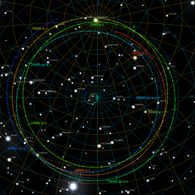
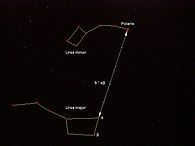
Due to the phenomenon of luni-solar precession, the Earth’s axis undergoes a circular movement with a radius of 23 degrees, shifting at a rate of approximately 1.397 degrees per 100 years. As a result, different stars take turns being the closest to the celestial pole at different times. For instance, during the pre-dynastic period of Ancient Egypt, which took place 5000 years ago, the star Tuban (alpha Dragon) held this position. However, during the beginning of our era, there were no bright stars near the celestial pole. In 2000 years from now, the closest star to the celestial pole will be Alrai (gamma Cepheus), and in 12,000 years, it will be Vega (alpha Lyra).
Nevertheless, the term “Polaris” specifically refers to the alpha star of the Little Bear constellation.
- 13,000 B.C. – Polaris is Vega, alpha Lyra.
- 9000 BC – The polar stars alternately are π and η Gepkuleca.
- 8000-7000 BC – The polar star is τ Gepkuleca.
- 5500-3500 BC – The polar star is ι Dpaqo’na.
- 3500-1500 BC – The polar star is Tuban, α of the Dragon.
- 1500 BC to 1 AD – The polar star is Cohab, β of the Little Bear.
- 1-1100 years – There is no polar star. However, there are “guards” – Cohab, β of the Little Bear, and Polaris, α of the Little Bear; the pole is approximately equidistant from α and β of the Little Bear.
- 1100-3200 – Polaris is α of the Little Bear. It will reach its minimum distance from the North Pole (0°27’34.1″) on April 23, 2102.
- 3200-5000 years – The polar star will be Alrai, γ Tsephaea.
- 5000-6500 years – The polar star will be Alfirk, β Cefea.
- 6500-8500 years – The polar star is Alderamin, α Cefea.
- Between 8500-13,000 years, the stars Deneb, α, and Sadr, γ in the constellation Lebedea will serve as the polar orientation.
- After 13,000 years, the star Vega, α in the constellation Lipy will once again become the polar orientation.
Orientation of Polaris [ edit edit code ]
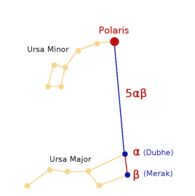
As Polaris expands, the sky rotates.
In the Northern Hemisphere, Polaris is always positioned above the northern point of the horizon, making it a useful tool for navigating terrain.
To locate Polaris, one must first locate the distinct configuration of seven bright stars known as the Big Dipper, which resembles a bucket. By drawing an imaginary line through the two stars, Dubhe and Merak, on the “wall” of the bucket, opposite the “handle,” one can determine the approximate location of Polaris. This line should be five times the distance between the two extreme stars. Polaris is located approximately at the end of this line. The direction to Polaris corresponds with the north, and its elevation above the horizon matches the observer’s latitude.
Notes [ edit code ]
- ↑Koleva M., Vazdekis A.Stellar population models in the UV. I. Characterization of the New Generation Stellar Library. Astronomy and Astrophysics / T. Forveille – EDP Sciences, 2012. – Vol. 538. – P. A143. – ISSN 0004-6361; 0365-0138; 1432-0746; 1286-4846 – doi:10.1051/0004-6361/201118065 – arXiv:1111.5449
- ↑Scott G. Engle, Edward F. Guinan, Petr Harmanec.Toward Resolving the Parallax Disagreement of Polaris: A Precise Distance to Our Closest Cepheid from Gaia DR2. The American Astronomical Society (July 16, 2018). Date of access: July 30, 2018.Archived August 29, 2018.
- ↑ 123Astronomers have calculated the precise distance to Polaris(Russian). (July 30, 2018). Archived July 30, 2018.Date of access: July 30, 2018.
- ↑HubbleSite: Search(unpublished).(unavailable link – history). hubblesite.org. Date of access: November 2, 2018.
- ↑Polaris: Surpassing Expectations and Constructing New Science(unpublished). . Date of access: December 9, 2012.Archived from the original on November 7, 2014.
- ↑ Wielen; Jahreiss; Dettbarn; Lenhardt; Schwan (2000). "Polaris: Astrometric orbit, position, and proper motion". arXiv: astro-ph/0002406Apxiv copy dated July 25, 2020 at the Wayback Machine.
- ↑ Evans, Sasselov. Polaris: Amplitude, Period Change, and Companions.
- ↑David G. Turner.Polaris and its Relatives (English) . arxiv.org (July 18, 2009). – review.Date of access: October 17, 2009.Archived January 8, 2017.
- ↑Astronomers disagree on the distance to the famous North Star November 30, 2012.(unpublished). . Date of access: December 9, 2012.Archived from the original on December 3, 2012.
- ↑Polar Star is closer than previously believed Archived December 9, 2012 at the Wayback Machine.
- ↑Astronomers disagree on the distance to the famous North Star.(not available). . Date of access: December 9, 2012.Archived from the original on December 3, 2012.
- ↑Bakulin P. I. General astronomy course. – 4th edition. – Moscow: “Nauka”, 1977. – 544 p.
- ↑J. Vondrak, N. Capitaine, P. Wallace. New precession expressions for long time intervals. – 2011.
- ↑ Astronomy // Encyclopedia for Children. – Moscow: Avanta+, 2007. – p. 269.





